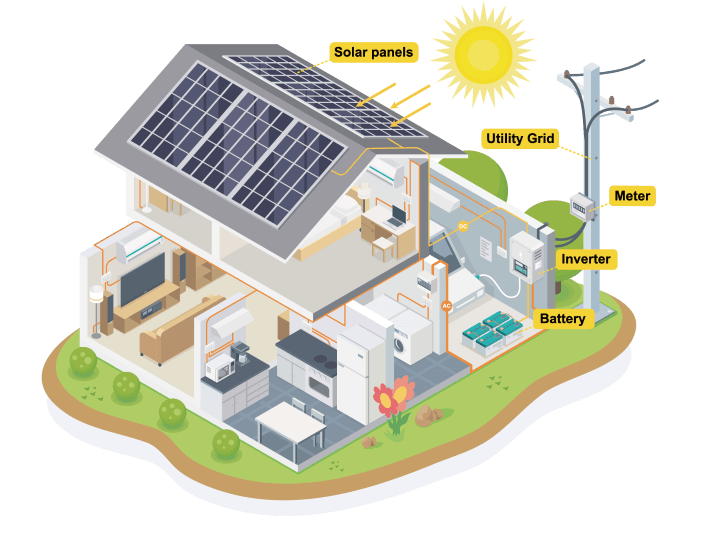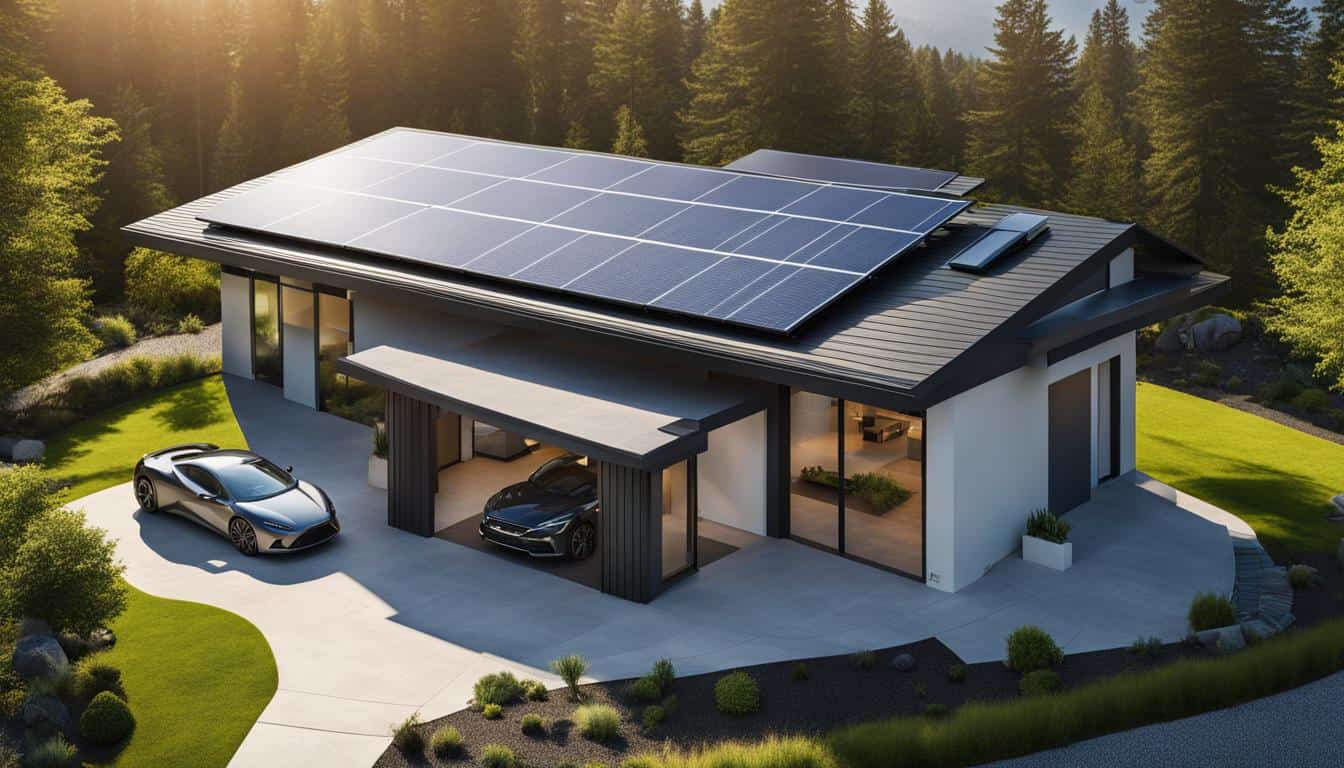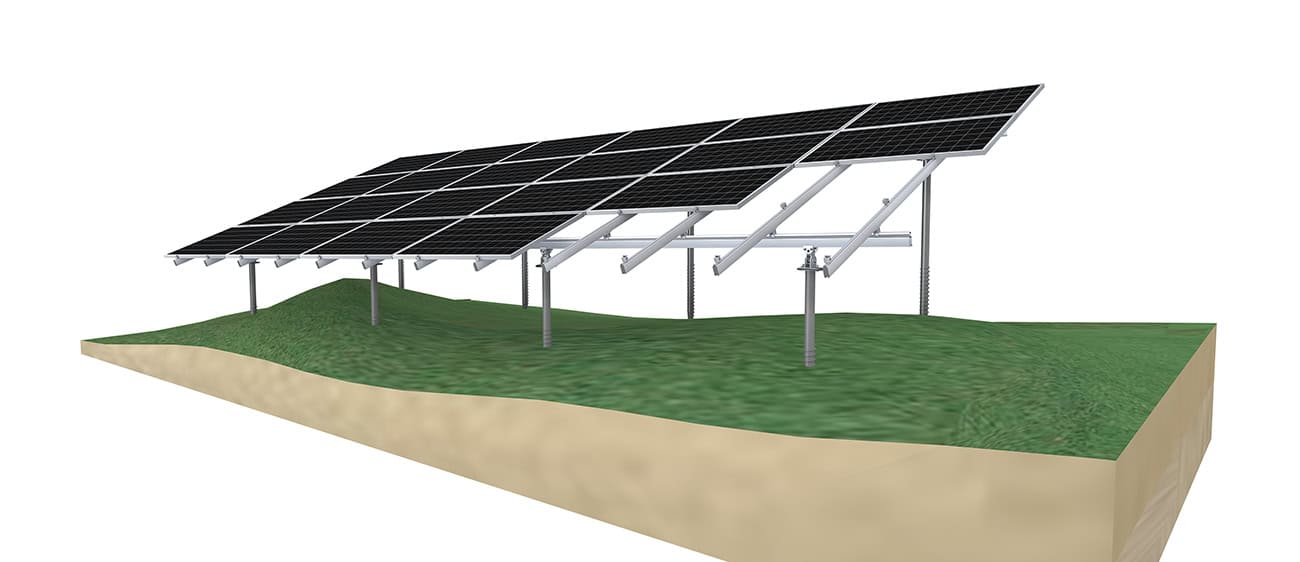Inhaltsübersicht
1. Introduction
1.1 Definition of a Hybrid Solar System
A Hybrid Solar System is a modern solution designed to harness solar energy efficiently. It combines solar panels, a hybrid inverter, and a battery bank to create a powerful energy system. The solar panels are responsible for capturing sunlight and converting it into electricity. This electricity, however, is in direct current (DC) form which is not suitable for running household appliances. Here’s where the hybrid inverter steps in, transforming the DC electricity into alternating current (AC), which is the standard form of electricity used in homes. Additionally, the hybrid inverter manages the battery bank, which stores excess electricity for later use. Essentially, a hybrid solar system provides the best of both worlds: it allows you to remain connected to the grid while also storing energy for use during power outages
1.2 How Hybrid Solar Systems Differ from Other Solar Systems
When venturing into the realm of solar energy, you’ll come across various types of solar systems, each with its own set of features and benefits. However, hybrid solar systems stand out due to their dual functionality. Unlike on-grid systems, which solely depend on the grid, or off-grid systems, which are entirely independent, hybrid solar systems offer a balanced approach. They maintain a connection to the grid, ensuring a constant power supply, and at the same time, they provide the option to store energy in a battery bank. This unique combination grants you the reliability of grid power with the independence and peace of mind of having backup power when needed. Moreover, hybrid solar systems are particularly beneficial for areas with unreliable grid power or expensive peak electricity rates, offering a level of energy independence without completely disconnecting from the grid
2. Components of a Hybrid Solar System
2. 1 Solar Panels
Solar panels are the cornerstone of any solar energy setup, including hybrid solar systems. They are installed in open areas with ample sunlight, such as rooftops or backyards. Each solar panel consists of many solar cells made from semiconductor materials like silicon. When sunlight hits these cells, it excites the electrons in them, creating an electric current. This process of converting sunlight into electricity is known as the photovoltaic effect. The electricity generated by solar panels is in direct current (DC) form, which is then sent to the hybrid inverter for conversion into alternating current (AC) suitable for home use. Learn more about the photovoltaic basics from the U.S. Department of Energy.
2.2 Hybrid Inverter
The hybrid inverter is a critical component that differentiates hybrid solar systems from other solar setups. It serves two main purposes: converting DC electricity from solar panels to AC electricity for home use, and managing the charging and discharging of the battery bank. Unlike traditional inverters, hybrid inverters have the capability to interact with both the grid and the battery bank, ensuring a seamless flow of electricity based on your needs. When excess electricity is generated, it either charges the battery bank or is sent back to the grid. During power outages or at times when solar generation is low, the battery bank can discharge stored electricity, ensuring a continuous power supply.
2.3 Battery Bank
The battery bank in a hybrid solar system stores excess electricity generated by solar panels for later use. This feature is particularly useful during the night when the sun is down, or during power outages, providing a reliable backup power source. The capacity of the battery bank is crucial as it determines how much electricity can be stored and consequently, how long your home can be powered during off-grid scenarios. Modern battery systems use lithium-ion technology, known for its higher energy density and longer lifespan compared to older battery technologies. The hybrid inverter manages the charging and discharging process of the battery bank, ensuring optimal performance and longevity of the system.
2.4 Mounting Hardware
Mounting hardware is essential for securing solar panels either on the roof or on the ground, ensuring they are positioned at the correct angle to capture maximum sunlight. The mounting structure needs to be robust to withstand various weather conditions and should be designed to provide optimal tilt and orientation to the solar panels, maximizing energy generation over time.
2.5 Cables
Cables are crucial for transmitting electricity from the solar panels to the hybrid inverter and from the inverter to your home’s electrical system. They also connect the inverter to the battery bank for charging and discharging. It’s vital to use high-quality, durable cables that can handle the current and voltage levels in your solar system to ensure safety and efficiency.
2.6 Accessories
Accessories for a hybrid solar system might include monitoring devices, disconnect switches, grounding equipment, and additional safety gear. Monitoring devices allow you to track the performance of your solar system in real-time, while disconnect switches and grounding equipment are essential for safety, allowing for system shut down during maintenance or emergencies.
3. Functionality
3.1 How Hybrid Solar Systems Work?
Hybrid solar systems operate in a sophisticated yet user-friendly manner. They seamlessly integrate solar panels, a hybrid inverter, and a battery bank to provide a continuous supply of electricity. During the day, solar panels capture sunlight and convert it into DC electricity. This DC electricity is then sent to the hybrid inverter, which performs two crucial roles: it converts DC to AC electricity for immediate use in your home, and it manages the charging of the battery bank with excess electricity.

When your solar panels produce more electricity than your home needs, the surplus is used to charge the battery bank. Once the battery bank is fully charged, any additional excess electricity is sent back to the grid, earning you credits on your electricity bill in areas with net metering policies. Conversely, during the night or cloudy days when solar generation is low, the battery bank discharges stored electricity to power your home. And if the battery bank runs low, you can draw electricity from the grid.
3.2 On-grid and Off-grid Capabilities
One of the hallmark features of hybrid solar systems is their ability to operate both on-grid and off-grid. This dual functionality is enabled by the hybrid inverter, which intelligently manages the flow of electricity between the solar panels, battery bank, and the grid.
On-grid operation allows you to benefit from the grid’s reliability while also taking advantage of solar power to reduce your electricity bills. In some regions, you can also earn credits for the excess electricity you feed back into the grid, further offsetting your energy costs.
Off-grid operation, on the other hand, is a lifesaver during power outages. When the grid goes down, the hybrid inverter isolates your system from the grid (a process known as islanding) and switches to off-grid mode. In this mode, your home is powered by the electricity stored in the battery bank and generated by your solar panels.
This flexible operation makes hybrid solar systems a highly appealing choice for homeowners seeking energy independence, reliability, and cost savings. By allowing you to use solar power, store it, and remain connected to the grid, hybrid solar systems provide a versatile solution for modern energy needs
4. Advantages of Hybrid Solar Systems
4.1 Energy Independence
One of the major advantages of hybrid solar systems is the level of energy independence they offer. By storing excess solar energy in a battery bank for later use, homeowners can reduce their reliance on the grid. This is particularly beneficial during power outages or in regions with unstable grid electricity. The ability to use stored solar energy when needed provides a sense of energy security and peace of mind.
4.2 Cost-effectiveness
Hybrid solar systems can be a cost-effective solution in the long run. They help in reducing electricity bills by maximizing the use of solar energy. Additionally, in regions with net metering policies, homeowners can earn credits for the excess electricity fed back into the grid, further lowering their energy costs. The smart features in hybrid inverters also allow for load shifting and peak shaving, which can lead to additional savings, especially in areas with time-of-use electricity pricing.
4.3 Seamless Transition between Grid and Battery
The hybrid inverter’s capability to manage the flow of electricity between the solar panels, battery bank, and the grid ensures a seamless transition between on-grid and off-grid operation. This seamless transition is crucial during power outages, ensuring that your home remains powered without any interruption. The hybrid inverter automatically switches to off-grid mode during a power outage, utilizing the stored energy in the battery bank to power your home.
4.4 Environmental Benefits
Hybrid solar systems contribute to reducing carbon emissions by harnessing clean, renewable solar energy. By utilizing solar power and reducing reliance on fossil fuel-based electricity from the grid, homeowners can significantly lower their carbon footprint, contributing to a cleaner, greener environment.
4.5 Increased Property Value
Solar installations, especially hybrid systems with battery storage, are seen as valuable additions to homes. They not only promise reduced electricity bills but also provide a modern, eco-friendly, and reliable energy solution, factors that can enhance property value.
5. Disadvantages of Hybrid Solar Systems
5.1 Initial Cost
The upfront cost of installing a hybrid solar system can be higher compared to traditional on-grid solar systems. This is primarily due to the inclusion of a battery storage system and a more complex hybrid inverter. The cost of the battery bank can significantly impact the overall price of the hybrid solar system. Moreover, the quality and capacity of the battery bank chosen will also play a role in the initial investment required.
5.2 Technical Complexity
Hybrid solar systems are more technically complex compared to standard on-grid solar systems. The integration of a battery storage system and a hybrid inverter that can manage both grid interaction and battery charging/discharging adds layers of complexity. This technical complexity may require specialized installation and maintenance services, which could potentially incur additional costs over time.
5.3 Battery Replacement and Maintenance
The battery bank in a hybrid solar system has a limited lifespan and will require replacement at some point, typically every 5 to 15 years depending on the technology and usage. The cost of replacing the battery bank can be substantial. Additionally, batteries may require maintenance to ensure they operate efficiently and safely, adding to the ongoing costs of the system.
5.4 Permitting and Grid Interconnection
In some regions, the process of getting the necessary permits and approvals for installing a hybrid solar system, especially the battery storage component, can be lengthy and challenging. Moreover, the requirements for grid interconnection and the availability of net metering or other incentives can vary widely, potentially impacting the feasibility and cost-effectiveness of hybrid solar systems.
6. Sizing a Hybrid Solar System
6.1 Importance of Correct Sizing
Sizing a hybrid solar system accurately is pivotal for its efficiency and cost-effectiveness. The size of your solar panel array, hybrid inverter, and battery bank needs to be tailored to your home’s energy needs to ensure you harness and store enough solar energy. Correct sizing not only meets your electricity requirements but also maximizes the return on your investment
6.2 Factors to Consider
6.2.1 Energy Consumption:
Analyzing your household’s energy consumption is the starting point for sizing a hybrid solar system. It’s essential to understand your daily and seasonal electricity usage patterns. Your electricity bills over the past year can provide valuable insights into your energy consumption trends.
6.2.2 Solar Energy Potential:
The amount of sunlight your location receives significantly impacts the size of the solar system you’ll need. It’s crucial to assess the solar energy potential in your area, considering factors like shading, the angle of your roof, and local weather patterns.
6.2.3 Battery Storage Capacity:
The capacity of the battery bank determines how much excess solar energy you can store for later use. A larger battery bank allows for more storage, providing a more reliable backup during cloudy days or power outages. However, it also comes with a higher price tag.
6.2.4 Peak Electricity Demand:
Understanding your home’s peak electricity demand helps in sizing the battery bank and the inverter. It ensures that your hybrid solar system can handle your electricity needs during peak usage times.
6.2.5 Future Energy Needs:
Anticipating any changes in your future energy consumption, like adding electric vehicles or new appliances, is crucial when sizing your hybrid solar system. It’s wise to plan for future energy needs to avoid the necessity of upgrading your system shortly after installation.
6.2.6 Local Regulations and Incentives:
Local regulations may dictate certain aspects of your hybrid solar system’s size, like the maximum allowed system capacity. Moreover, understanding the available incentives and subsidies for solar and battery storage in your area can impact the economic feasibility of different system sizes.
Sizing a hybrid solar system is a nuanced task that requires a thorough understanding of your energy needs, local solar conditions, and financial considerations. It’s advisable to consult with experienced solar installers or use advanced solar calculators to get an accurate sizing for your hybrid solar system.
7. Installation Considerations
7.1 Placement of Solar Panels
The placement of solar panels is crucial for maximizing energy generation. Solar panels should be installed in locations with minimal shading and optimal sun exposure throughout the day. The angle and orientation of the panels also significantly affect their energy-harvesting efficiency. In the northern hemisphere, solar panels are typically oriented towards the south, and vice versa in the southern hemisphere, to capture the maximum sunlight. Professional solar installers can provide valuable insights and recommendations on the best placement of solar panels based on your location and roof characteristics.
7.2 Wiring and Integration
Proper wiring and integration are essential for the safety and efficiency of your hybrid solar system. High-quality cables and connectors should be used to ensure minimal energy loss and to prevent potential electrical hazards. The integration of the solar panels, hybrid inverter, and battery bank needs to be done correctly to ensure seamless operation of the system. It’s advisable to hire experienced solar installers who are knowledgeable about local electrical codes and standards to ensure a safe and efficient installation.
7.3 Battery Placement
The placement of the battery bank is another critical consideration. Batteries should be installed in a clean, dry, and well-ventilated area to ensure they operate efficiently and have a long lifespan. It’s also essential to follow the manufacturer’s instructions and local electrical codes regarding battery placement and enclosure to ensure safety.
7.4 Monitoring System Installation
Installing a monitoring system allows you to track the performance of your hybrid solar system in real-time. Monitoring systems provide valuable data on energy generation, consumption, and battery status, enabling you to optimize your energy usage and detect any issues early.
8. Maintenance and Monitoring
Regular maintenance is key to ensuring the longevity and efficiency of your hybrid solar system. Routine checks should be conducted to inspect the physical condition of solar panels, mounting hardware, and cables for any signs of damage or wear. It’s also advisable to keep the solar panels clean from dust, dirt, bird droppings, and other debris that can obstruct sunlight and reduce energy generation. The battery bank and hybrid inverter should also be inspected for any abnormalities, ensuring they are operating correctly.
Performance monitoring is crucial for optimizing the use of your hybrid solar system. Modern hybrid solar systems often come with monitoring software that allows you to track energy generation, consumption, and battery status in real-time. Monitoring systems provide valuable insights into how your solar system is performing, helping you identify any issues early and make informed decisions to optimize your energy usage. Understanding the data provided by the monitoring system can also help you detect any underperformance issues that may require professional troubleshooting.
Battery maintenance is crucial for ensuring a long lifespan and optimal performance. Depending on the type of battery technology used, maintenance requirements may vary. For example, lithium-ion batteries generally require less maintenance compared to lead-acid batteries. Following the manufacturer’s maintenance guidelines and ensuring the battery bank is operating within the recommended temperature range can significantly impact its performance and lifespan.
9. Future Trends
Technological Advancements
The field of solar technology is constantly evolving, with new advancements aimed at improving the efficiency, reliability, and affordability of solar systems. Hybrid solar systems stand to benefit significantly from these advancements. For instance, the development of more efficient solar panels and batteries can enhance the performance and energy storage capabilities of hybrid systems. Additionally, smart inverters and monitoring systems equipped with artificial intelligence and machine learning algorithms can provide better management and optimization of energy usage. Stay updated with the latest solar technology advancements at PV Tech.
Policy and Incentives
As the global push towards renewable energy intensifies, many regions are introducing favorable policies and incentives to promote solar energy adoption. These policies can include net metering, tax credits, and grants for solar installations, which significantly impact the affordability and attractiveness of hybrid solar systems. Moreover, some regions are implementing grid codes and technical standards to facilitate the integration of solar systems with the existing grid infrastructure, making it easier for homeowners and businesses to adopt hybrid solar systems.
Grid-interactive Systems
The concept of grid-interactive solar systems is gaining traction. These systems are designed to interact dynamically with the grid, providing benefits like grid support and demand response. Hybrid solar systems, with their ability to manage energy flow between solar panels, battery storage, and the grid, are well-positioned to evolve into grid-interactive systems. This evolution can enable hybrid solar systems to play a crucial role in modernizing the electrical grid and enhancing grid resilience.
Community Solar and Microgrids
Community solar projects and microgrids are emerging trends that promote shared renewable energy resources. Hybrid solar systems can play a significant role in these setups, providing reliable, localized energy generation and storage. As part of a microgrid, hybrid solar systems can contribute to energy self-sufficiency and resilience in communities, especially in remote or disaster-prone areas.
Battery Technology
Advancements in battery technology are expected to continue, leading to higher energy storage capacities, longer battery life, and lower costs. Enhanced battery technology will boost the appeal of hybrid solar systems by improving their energy storage capabilities and making them more financially accessible to a broader segment of the population.
10. Conclusion
10.1 Summary of Key Points
Hybrid solar systems present a compelling solution for modern energy needs, bridging the gap between on-grid and off-grid solar systems. They offer the reliability of grid connection while providing the independence of energy storage, ensuring a continuous power supply even during grid outages. Through a combination of solar panels, a sophisticated hybrid inverter, and a battery bank, hybrid solar systems harness solar energy efficiently, store it for later use, and manage the energy flow seamlessly.
The benefits of hybrid solar systems extend beyond energy independence to cost savings on electricity bills, reduced carbon emissions, and increased property value. Although they come with higher initial costs and technical complexity, the long-term advantages they offer make them a worthwhile investment for many homeowners and businesses.
10.2 Recommendations for Prospective Users
For those considering investing in a hybrid solar system, thorough research and careful planning are crucial. Understanding your energy needs, the solar potential of your location, and the local regulations and incentives can significantly impact the success of your solar project. Consulting with professional solar installers, exploring various financing options, and considering future energy needs are essential steps in the journey towards harnessing solar energy through a hybrid solar system.
Moreover, embracing the monitoring and maintenance aspects of hybrid solar systems will ensure their longevity and optimal performance, maximizing the return on your investment. Staying updated on technological advancements and policy changes in the renewable energy sector can also provide valuable insights and opportunities to enhance the benefits of your hybrid solar system.
11. Glossary
Alternating Current (AC)
A type of electrical current that reverses direction periodically, as opposed to direct current (DC) that flows in one direction only. AC is the standard form of electricity used in homes and businesses.
Battery Bank
A collection of batteries connected together to store electrical energy. In a hybrid solar system, the battery bank stores excess solar energy for later use.
Direct Current (DC)
A type of electrical current that flows in one direction only. Solar panels generate electricity in DC, which needs to be converted to AC for use in homes and businesses.
Hybrid Inverter
A device that converts DC electricity from solar panels to AC electricity for use in homes and businesses. It also manages the charging and discharging of the battery bank in a hybrid solar system.
Kilowatt (kW)
A unit of power equal to 1,000 watts, commonly used to describe the capacity of solar systems and other electrical devices.
Kilowatt-hour (kWh)
A unit of energy equal to the amount of energy used by a 1,000-watt device over one hour. It’s commonly used to measure electricity consumption and generation.
Net Metering
A billing arrangement that allows solar system owners to earn credits for excess electricity fed back into the grid, which can be used to offset electricity bills. Discover the benefits of net metering from the Solar Energy Industries Association.
Photovoltaic Effect
The process by which solar cells in a solar panel convert sunlight into electrical energy.
Time-of-Use Pricing
An electricity pricing scheme where the cost of electricity varies depending on the time of day, typically being more expensive during peak demand times.





